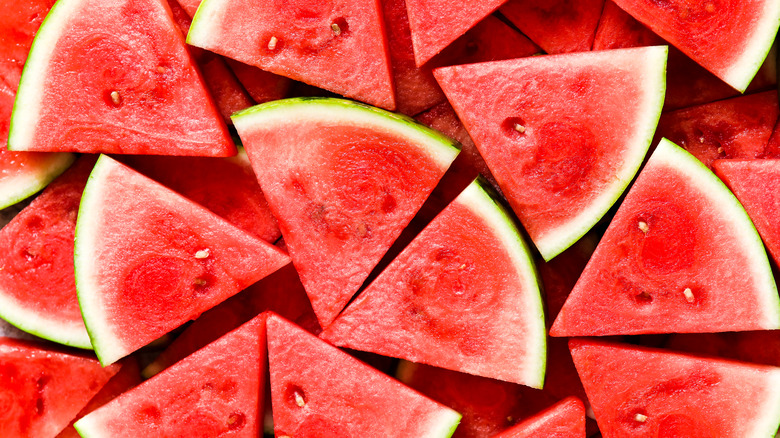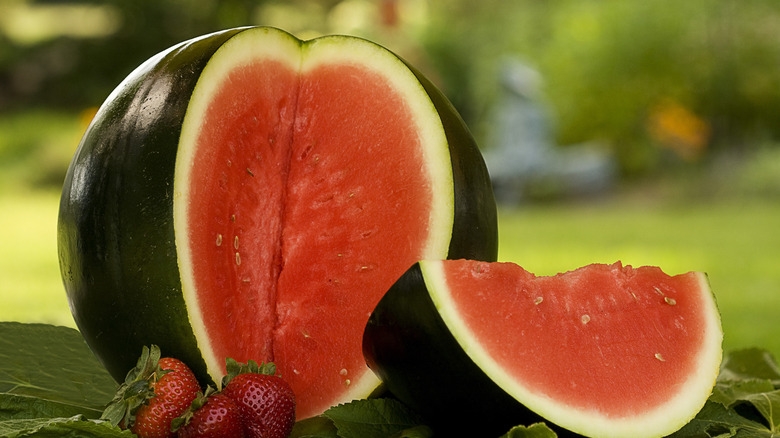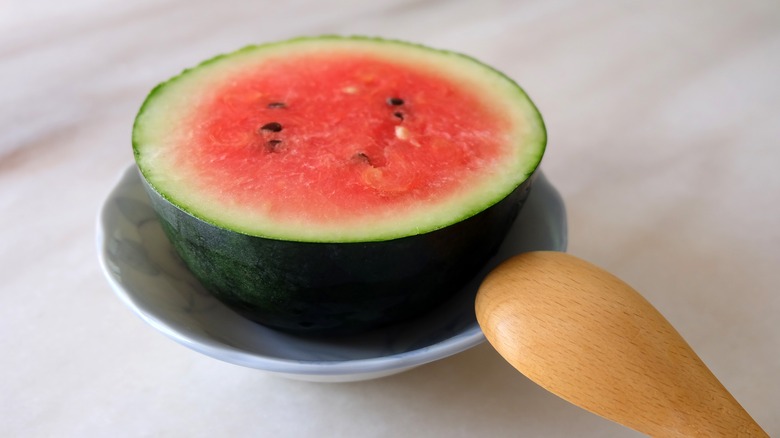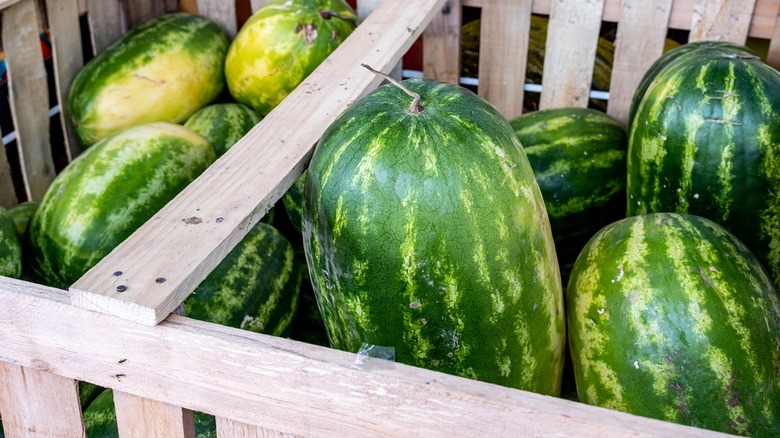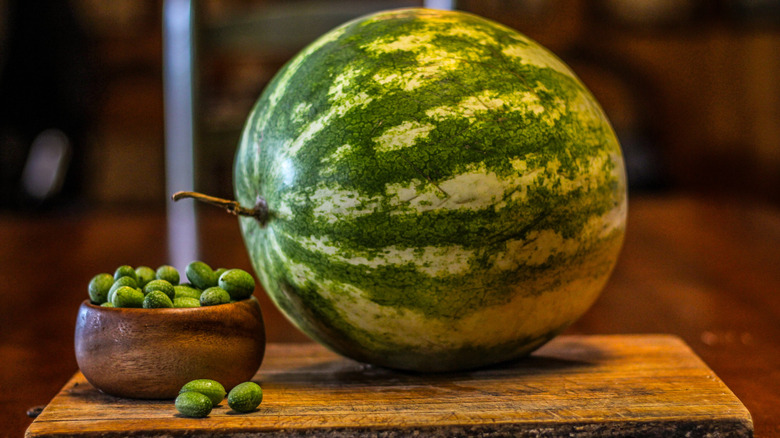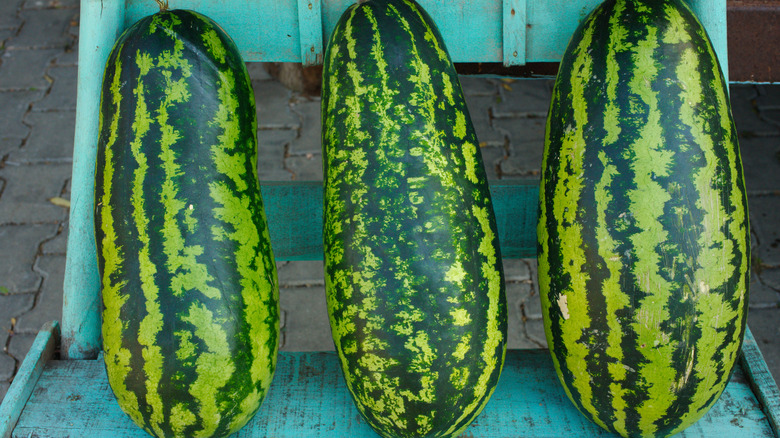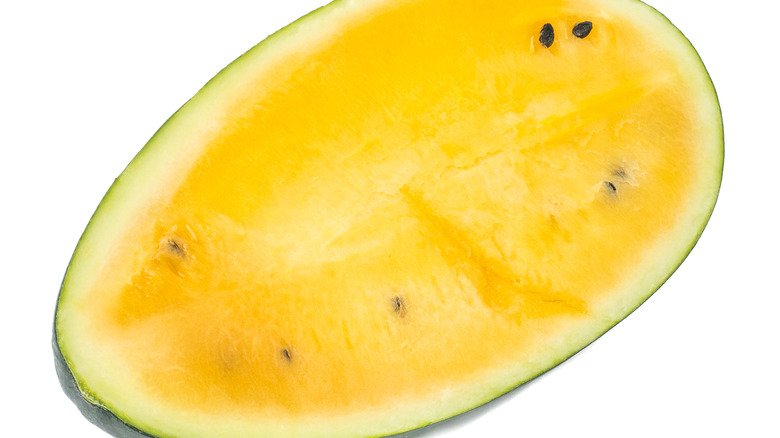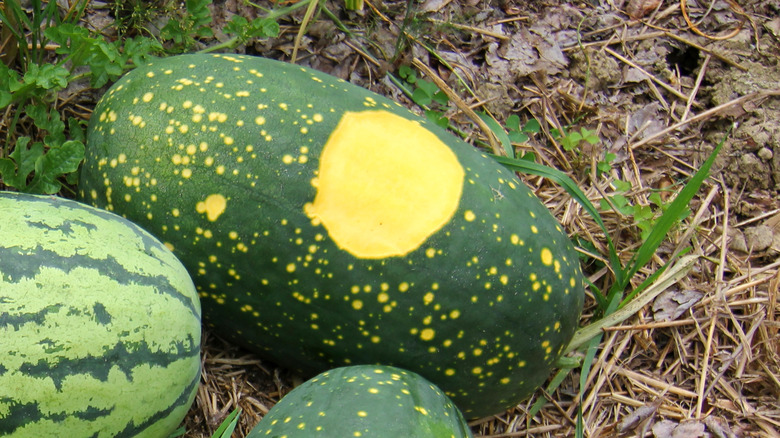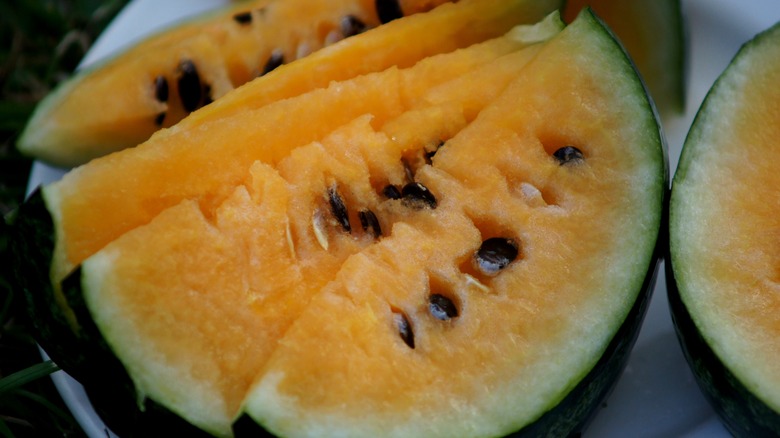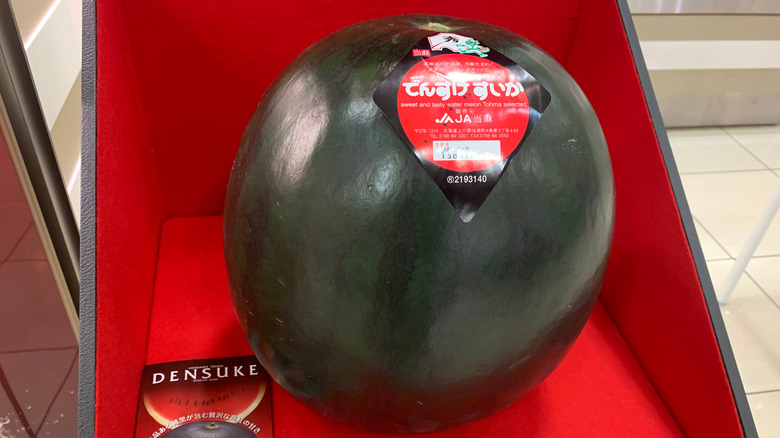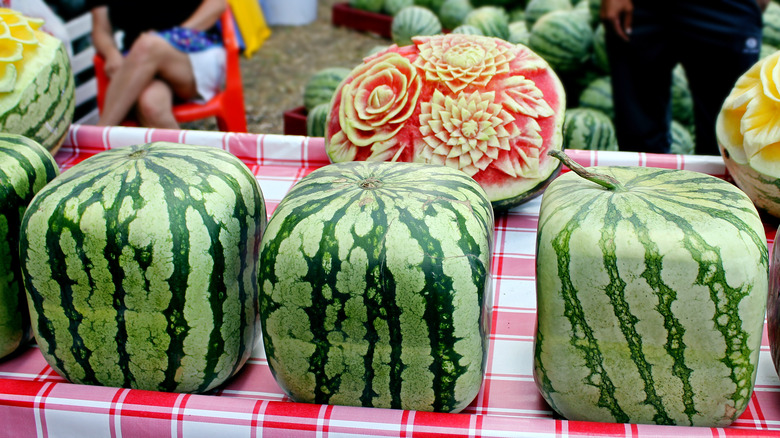10 Types Of Watermelons You Can Grow In Your Backyard
We may receive a commission on purchases made from links.
Everybody knows what a standard watermelon looks like. But did you know how many funky cultivars there are of this fruit that is second only to the tomato when it comes to the world's most popular? Over 1,200 says Washington State University, with close to 300 of them regularly grown throughout the U.S., particularly in Texas, Florida, California, Georgia, and Indiana.
From pink to red to orange and yellow, watermelon flesh comes in a range of hues that are impossible to identify until you cut one open. They are the epitome of summertime picnic fruit. In fact, watermelons are so beloved they have a national day named after them! No need to worry about your USDA hardiness zone when it comes to growing these crowd pleasers because it doesn't matter what part of the country you live in. All watermelons are grown as summer annuals and need to be replanted on a yearly basis.
Cornell University explains that every type of cultivated watermelon is a variety or hybrid version of the original Citrullus lanatus species. There are six other species of watermelon that grow in the wild, but sadly, they are bitter and inedible. Pertaining to the sweet and delicious cultivated varieties, Watermelon.org groups them into four main categories: seeded, seedless, mini, and those that have yellow or orange flesh. Most tend to be oblong in shape, although the minis are more like perfectly spherical duckpin bowling balls.
1. Sugar Baby
Sugar babies (Citrullus lanatus 'Sugar Baby') set the standard for icebox watermelons. These smaller-than-average melons got their nickname for their ability to fit inside refrigerators, which used to be called iceboxes back in the day. The globe-shaped sugar baby variety has red flesh, seeds, and a tough, thick, dark green rind.
Harvest: 76 days from seed planting to maturity
USDA Growing Zone: Summer annual
Growing Conditions: Full sun, stop watering for the last week before harvest
Soil Type: Light, well-draining
Size: 8 to 10 pounds
2. Mini Love
Oh, the precious mini love! For an even tinier single-serve variety, try growing these adorable mini love watermelons (Citrullus lanatus 'Mini Love'). Per Johnny's Select Seeds, these plants tend to be highly productive and their red-fleshed seeded fruits ripen about a week earlier than most others. Serve it up with breakfast just like you would half a grapefruit.
Harvest: 70 days from seed planting to maturity
USDA Growing Zone: Summer annual
Growing Conditions: Full sun, stop watering for the last week before harvest
Soil Type: Light, well-draining
Size: 5 to 7 pounds
3. Carolina Cross
From the tiny mini love, we jump to the enormous oblong Carolina Cross (Citrullus lanatus 'Carolina Cross'). According to Burpee, it'll be an average of 100 days before you can harvest one of these beasts. Considering they're known to grow as big as 200 pounds, that timeline actually seems rather short. Good luck getting yours home after buying it at the farm stand!
Harvest: 100 days from seed planting to maturity
USDA Growing Zone: Summer annual
Growing Conditions: Full sun, stop watering for the last week before harvest
Soil Type: Light, well-draining
Size: 50 to 200 pounds
4. Crimson Sweet
The Crimson Sweet (Citrullus lanatus 'Crimson Sweet') variety is a delicious, though rather ordinary, watermelon with yellow stripes on its exterior rind and sweet, pink, seeded flesh on the inside, as per Burpee. It's easy to grow and makes the perfect summertime treat; great in fruit salads or as a thickly sliced wedge on its own.
Harvest: 85 days from seed planting to maturity
USDA Growing Zone: Summer annual
Growing Conditions: Full sun, stop watering for the last week before harvest
Soil Type: Light, well-draining
Size: 15 to 25 pounds
5. Jubilee
Citrullus lanatus 'Jubilee' watermelons tend to grow longer and skinnier than the other oblong cultivars. They have a light lime tone to their rinds and dark green stripes. The Jubilee variety is a classic picnic watermelon with exceptionally sweet, crisp red flesh.
Harvest: 80 to 90 days from seed planting to maturity
USDA Growing Zone: Summer annual
Growing Conditions: Full sun, stop watering for the last week before harvest
Soil Type: Light, well-draining
Size: 25 to 40 pounds
6. Sunshine
Sunshine, Yellow Doll, Honey Heart — yellow watermelons go by many nicknames. Whichever type you end up with, know that it will be adored by all for its surprising bright yellow flesh and a flavor that many claim to be sweeter and more honey-like than the typical red fruits. For a seedless yellow-fleshed cultivar, try to find the Amarillo variety.
Harvest: 75 to 100 days from seed planting to maturity
USDA Growing Zone: Summer annual
Growing Conditions: Full sun, stop watering for the last week before harvest
Soil Type: Light, well-draining
Size: Various depending on cultivar
7. Moon & Stars
Century Star, (Citrullus lanatus 'Century Star') watermelons have funky yellow spots on their rinds that resemble the constellations in the nighttime sky. Their heirloom variety cousins are called Moon & Stars because they tend to have one yellow spot (the moon) that is much bigger than the others (the stars).
Harvest: 80 days from seed planting to maturity
USDA Growing Zone: Summer annual
Growing Conditions: Full sun, stop watering for the last week before harvest
Soil Type: Light, well-draining
Size: 10 pounds
8. Orangeglo
The unique orange flesh of the Citrullus lanatus 'Orangeglo' watermelon was brought to the world courtesy of the Willhite Seed Company of Poolville, Texas, back in the 1960s, according to Mother Earth News. The Orangeglo is another oblong, light- and dark-green-striped watermelon on the outside that offers a delightful twist on the inside and a noteworthy flavor with its crisp citrus-toned flesh.
Harvest: 85 days from seed planting to maturity
USDA Growing Zone: Summer annual
Growing Conditions: Full sun, stop watering for the last week before harvest
Soil Type: Light, well-draining
Size: 15 to 25 pounds
9. Densuke
Densuke (Citrullus lanatus 'Densuke') watermelons are high maintenance and difficult to grow. But if you really want to taste one, you'd better get your hands on some seeds and start putting in the work. These unusual, almost-black-skinned watermelons, native to Hokkaido, can cost thousands of dollars at the market in Japan. If densukes seem too otherworldly, you might try the heirloom black diamond variety instead.
Harvest: 95 days from seed planting to maturity
USDA Growing Zone: Summer annual
Growing Conditions: Full sun, stop watering for the last week before harvest
Soil Type: Light, well-draining
Size: Up to 25 pounds
10. Japanese square watermelon
If the rare densuke piqued your interest, why not try your hand at cultivating a Japanese square watermelon? Per What About Watermelon, to create a unique fruit sure to wow everyone at the picnic, place a tempered glass box around a small melon when it's developing on the vine. As it grows, it'll have no choice but to take that shape.
Harvest: 75 to 100 days from seed planting to maturity
USDA Growing Zone: Summer annual
Growing Conditions: Full sun, stop watering for the last week before harvest
Soil Type: Light, well-draining
Size: Various depending on cultivar
